5 January 2014. Those of you who read the blog regularly know that I was in South America 35 years ago. I did a four-month overland trip from Cartegena on the Colombian Caribbean coast all the way down to Punta Arenas at the end of Chile and back up through Argentina to Rio de Janeiro in Brazil. It was a long time ago and I remember only a few highlights. One of those highlights was a market somewhere near Cusco in Peru. I remembered it for its colour and the uniqueness of the women’s clothing.
As we were doing our research for our travel in Peru I kept trying to find this market. Don mentioned Ollantaytambo, and I said that’s it! That’s the market! Then as we researched more about where to go in South America, the name of Otavalo in Ecuador came up. Once again – that’s it! That’s the market. It’s not Ollantaytambo, it’s Otalavo. Some time later, I think after we arrived in Cusco, I looked at a map and there it was – Chinchero. This time I knew I’d found it.
Chinchero is a small Andean village about 30 kilometres from Cusco. The market is held every day, but Sunday is the best and busiest day. The main road through Chinchero from Cusco takes you through an ordinary, somewhat unattractive, fairly typical Peruvian rural town. Not someplace you’d bother to stop really. But head along a side street and up the hill and things change. You start to get into the narrow cobble-stone streets and adobe buildings of an earlier time, but which are still very much in use today,
and quickly come to the famous market. I remember an open space crowded with women, all dressed in the most colourful beautiful traditional clothing, sitting on the ground selling their goods, ranging from fruits and vegetables to textiles, and weavings and other crafts. Chinchero is known for its exquisite, finely detailed weaving. It was a local market in the truest sense and there were very few tourists there. It has changed somewhat. It is now has palm leaf roofing. There are still many women in traditional dress. Some are dressed that way for tourists, some simply because that is the way they’ve always dressed. As in most cultures the majority of the men and the young women have largely given up on traditional dress, but not all of them. And now at the market there are also women from other villages who have their own unique style.
Chinchero market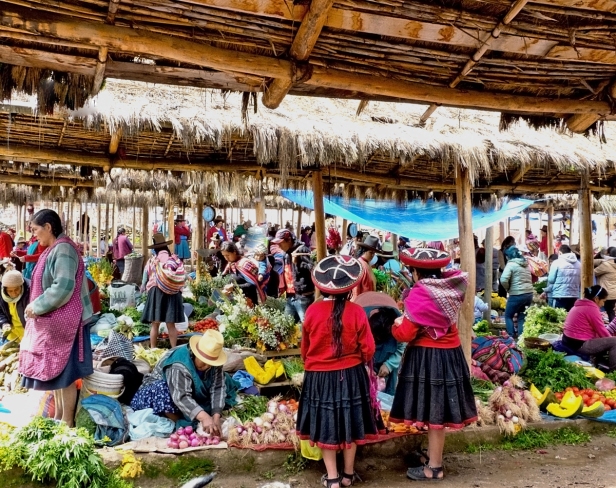
and young women in the traditional dress of Chinchero.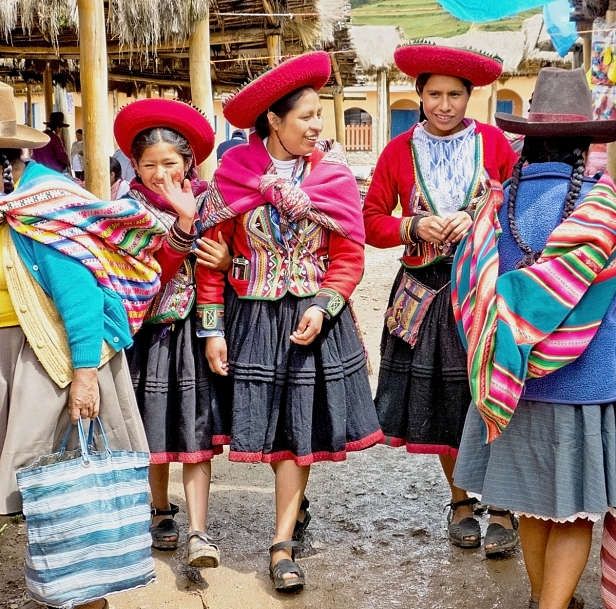


In the Andes Mountains in Copacabana, Bolivia I asked someone why some women wore straw hats, some bowlers, and some fedoras. She said the hat (and presumably the rest of the outfit) denotes your heritage and which village you’re from. I imagine it is the same in Andean Peru. Apart from those dressed in the clothing of Chinchero, there were many women at the market wearing fedoras.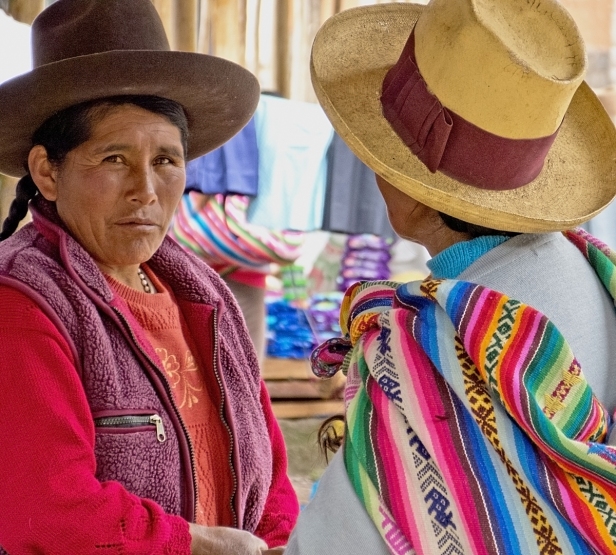



And if one is good, two is better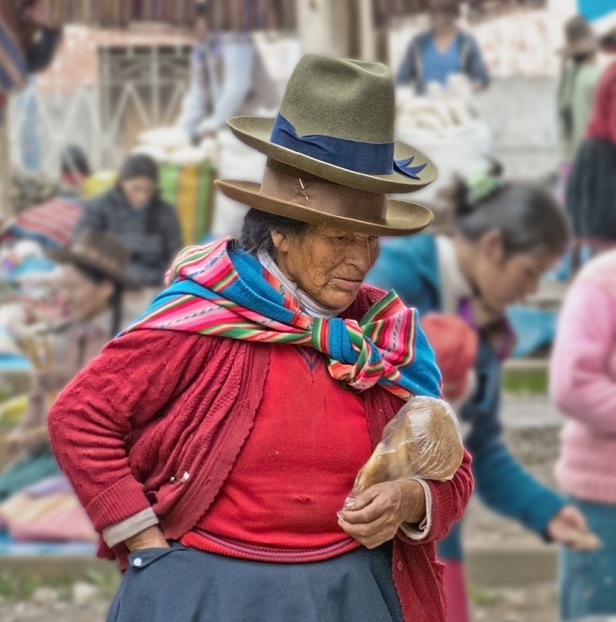
Seriously, I am immensely curious to know why she is wearing two hats but felt it would be rude to ask, and I may not have understood her answer. More likely than not it would have been in the Quechua language. Perhaps she was taking care of a hat for a friend.
Stove-pips hats were also in evidence, seen here at this market ‘restaurant’.
There was one lone man. He doesn’t look very happy.
Wandering up from the market I saw this:
and, of course, immediately wanted to explore further. We discovered it was a sacred ceremony of the Chinchero people held on the first Sunday of each month. Once again we’d lucked into a local ceremony, a wonderful blend of Catholicism and the ancient Andean worship of the earth mother Pachamama, and other nature gods. The people of the Andes are nominally Catholic and incorporate it into their traditional religion. The emphasis varies from region to region. In dry areas, such as Isla Del Sol in Lake Titicaca the emphasis is on worship of the Rain God, in areas of little sun the emphasis is on worship of the Sun God. The Sun God was the chief god of the Incas. All worship Pachmama, and almost always splash a little beer onto the ground for Pachamama before, and after, taking a drink.
Climbing further up we came upon this:
a group of about one hundred people, about equal numbers of men and women, seated in a long oval out the front of a small whitewashed adobe building where a priest was leading a religious ceremony. Leaning against the building were two large and elaborately decorated crosses.
After some time they all filed up the hill,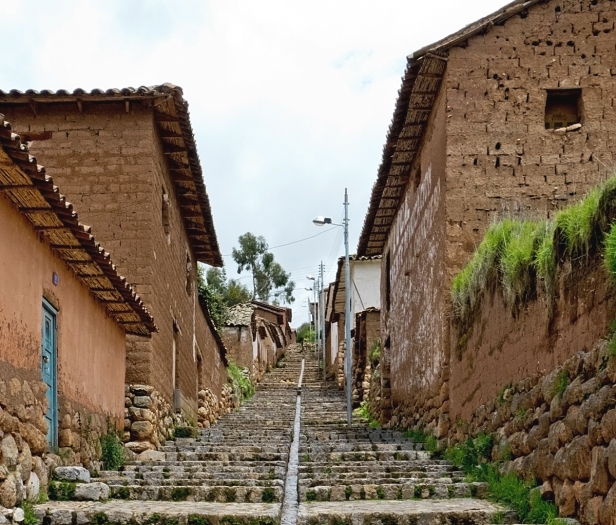
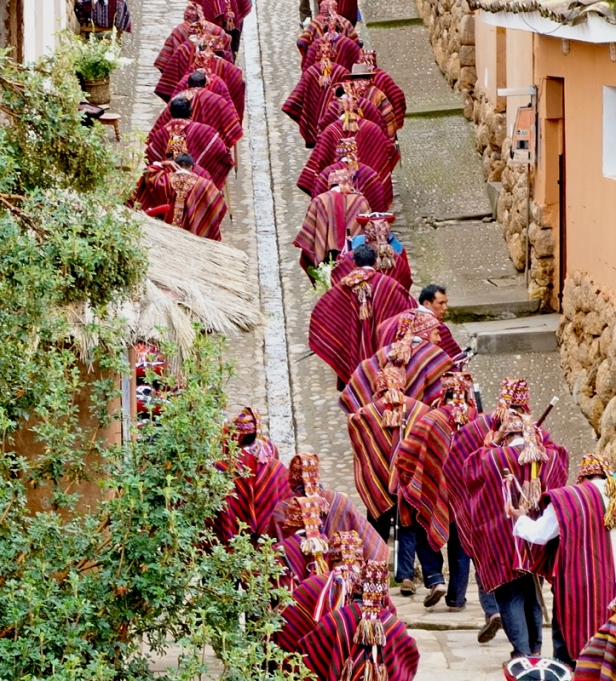
the men going first and carrying the crosses. They came to the church of Chinchero situated next to the wide-open space of the Plaza des Armas. The church was built in the early 1600’s on the Inca foundations of a palace that had been destroyed by the Spanish Conquistadors.
Waiting to enter the church

We had a quick peek inside the crowded church and decided this would be a good time to explore the adjacent Inca ruins. Once again we discovered the remains of the Inca Empire on a vast scale: the foundations of long gone buildings, and enormous agricultural terraces, many of which are still in use today. Wandering around for an hour or so, we hardly saw more than half of it.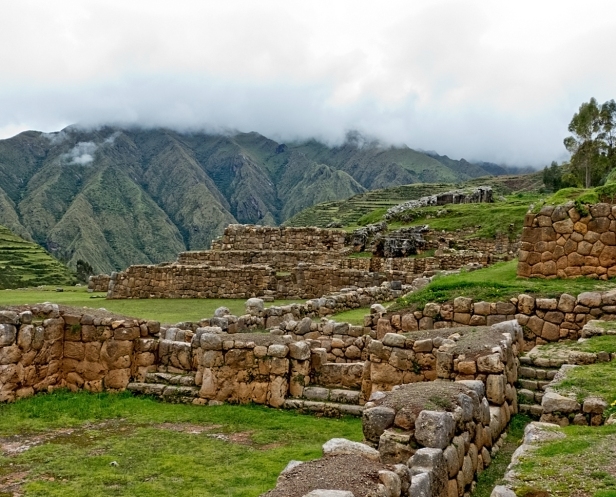
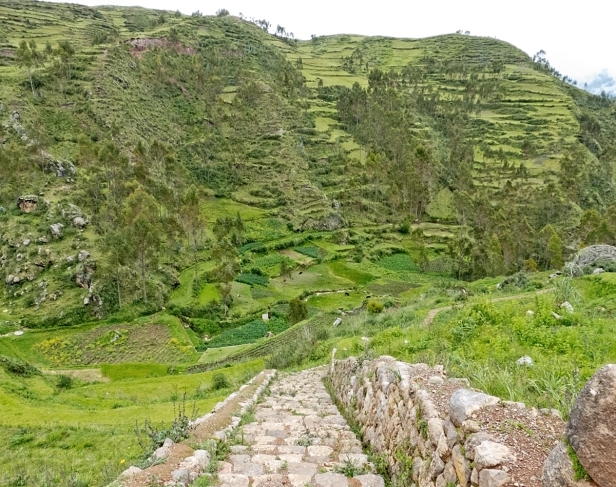
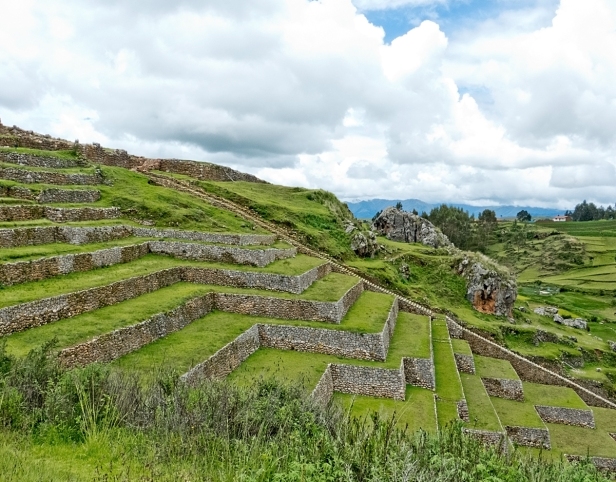
Our timing was perfect. We returned just as the people were all spilling out of the church.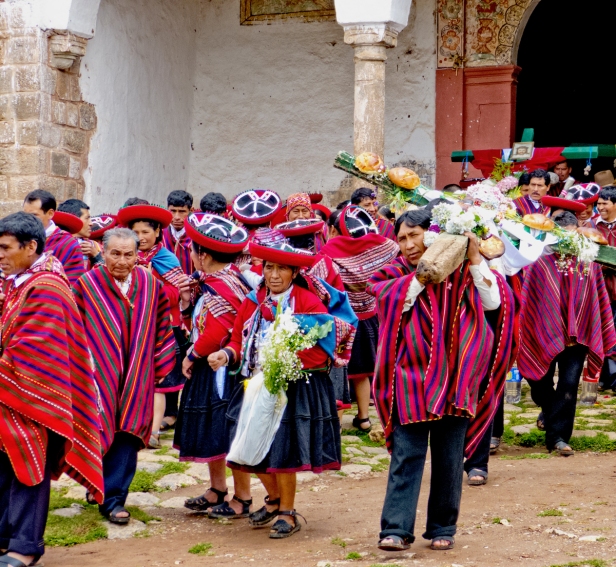
The first thing I noticed was this man with his elaborate floral headdress on what looks like one of the women’s hats over his own knitted hat.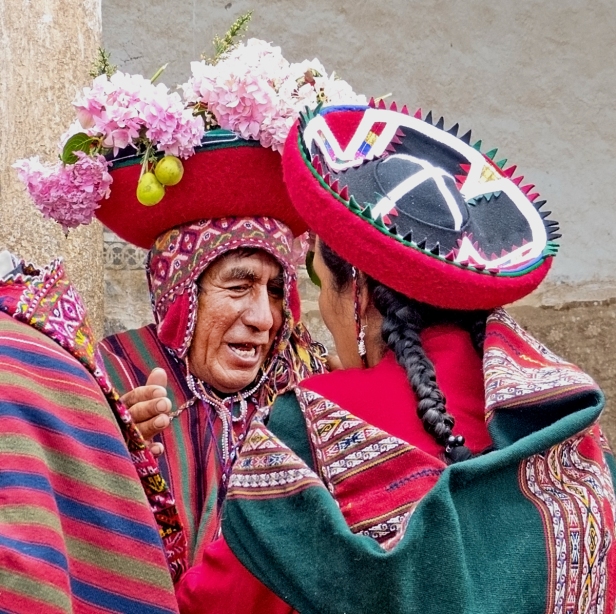
Then I noticed there was also a younger man, and a boy, with floral ‘necklaces’. Later they all posed for official photographs.
And I also noticed two or three of the men emerged from the church carrying big bundles of spears. You can see three of them stuck into the ground in the photo above. It all made me mildly rueful that I hadn’t stayed to watch the ceremony in the church. It was clearly no ordinary Catholic Church service.
Eventually they filed back down to the small building where they had begun. The women all hugged each other, and then everyone had a big feast.
In the photo above, of a woman about to embrace the man with flowers on his hat, you can see there is a line around the crown on the woman’s hat. It is a flap that can be lifted. The women keep their money in there and then wear their hats turned inside out. Like this: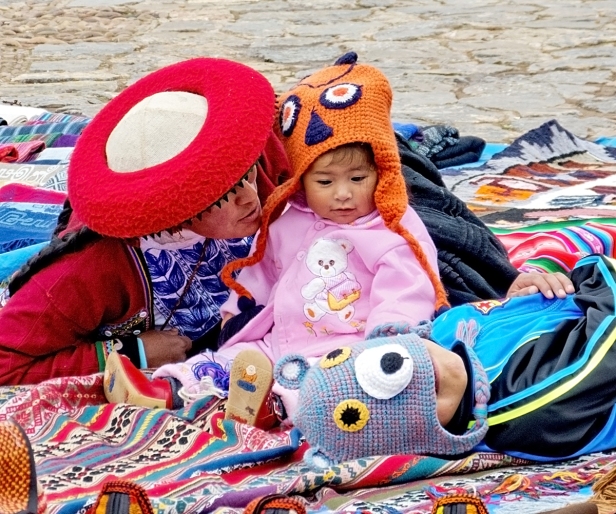
We noticed that the women didn’t wear their hats during the ceremony that took place where we initially discovered them, they did wear their hats while filing up to the church, and again coming back down, then either removed them or wore them inside out during the feast. I’d love to know the significance of it all, but alas Google would not give up these secrets.
Once again we experienced a full day rich with local culture. Some of it at the market was definitely a show for tourists, but the rest, the people of the region going about their normal business at the market, and the first-Sunday-of-every-month religious ceremony was a window into the regular lives of these people of the Andes.
Next post: The two biggest, and most famous, of the Inca archeological sites – Pisac, and the incomparable Machu Picchu.
All words and images by Alison Louise Armstrong unless otherwise noted.
© Alison Louise Armstrong and Adventures in Wonderland – a pilgrimage of the heart, 2010-2015.

Absolutely amazing photos and story! Thanks for writing about this very interesting area. Anita
LikeLike
Thanks so much Anita. It really is a fascinating part of the world. You headed this way?
Cheers, Alison
LikeLike
Great story…. and what a place it is!
Striking colors… irresistible for some one who loves taking photos 🙂
Thanks a lot for sharing…
LikeLike
Thanks Sreejith. I just love the colours! You are so right – irresistible!
LikeLike
Great post and photos! Such vibrant colors. 🙂
LikeLike
Thanks Paulette. It really was an amazing day. We went for the market, but we had no idea that that ceremony would be happening. It really made the day. I loved their outfits when I saw them way back when, so to see so many of them again was really special.
LikeLike
I always am attracted to farming terraces as a subject for photography, whether found in Asia or South America. The way they work their way around hills gives them a feel of being part of the natural landscape. Great photos as always, Alison and Don. –Curt
LikeLike
Thanks Curt. Aren’t farming terraces fascinating – I’m constantly amazed by the sculpture of them, and the sheer hard work and fierce determination that must go into creating them. I love the SE Asian ones especially that follow every natural curve of the land.
LikeLike
Also, they seem to last forever. Maybe its all the work that goes into carving them out of mountains, as you mention. –Curt
LikeLike
Fascinating, thank you. MM 🍀
LikeLike
Thanks MM, and you’re welcome. Such a richness of culture and tradition. I love the colours!
LikeLike
The richness of colour and traditional dress reminds me of the tribes in Vietnam. In Ecuador there wasn’t nearly so much colour. MM 🍀
LikeLike
Yes! Me too – I remember the Flower Hmong at Bac Ha – completely unrestrained use of colour. In Ecuador so far we’ve only been to Otavalo – beautiful but definitely more restrained. Yet to discover what’s in the villages around Cuenca, but from a woman I saw yesterday I’m anticipating stove pipe hats.
LikeLike
Enjoy Cuenca, a beautiful city.
LikeLike
Oh to be there and be able to buy some of the fabulous material/clothing. So colourful and beautiful!
LikeLike
I think you would go nuts here! A lot of the weavings available are not natural fibres and colours and are made for the tourist trade, but it is not at all hard to find the real thing. Some of the weaving is so intricate I’m astonished by it. Yes – so colourful and beautiful.
LikeLike
Incredibly beautiful photos. Love the one with the lady sitting in the blue dress with the older lady walking by, and the one with the two kids. Great detailed info. We are also fascinated with ruins wherever we travel…
LikeLike
Thank you so much. I had a lot of fun photographing that day with all the colour. That woman in the blue dress selling her vegetables – larger than life! And I watched the old lady for quite a while as she went slowly about her ordinary day getting her veggies at the market. You can see she’s been wearing that style of clothing all her life, and knows nothing else.
If you love ruins get yourself down to Peru – so many different sites to look at 🙂
LikeLike
Ooh, I can’t wait to hear about Machu Picchu!
But until then, another wonderful post. The colors are indeed very vibrant. And one has to wonder what the spears were for . . .
LikeLike
Thanks Felicity. Yes, I also wonder what the spears were for! And the flowers. And the man wearing one of the women’s hats. And I also noticed one of the women had flowers in her hat that weren’t there before going into the church. Wish I had enough Spanish, or Quechua, to have been able to ask at the time, but alas . . . . .
LikeLike
Fabulous experience and photos!
LikeLike
Thanks Cindy. Catching up with your posts soon 🙂 don’t want to miss all those wonderful photos.
LikeLike
I am so jealous that time is allowing you to see so much more than the average tourist with limited holiday time.
Though I am grateful you are happy to share your experiences with the rest of us.
Mine turn is coming with a one way ticket now purchased for Central America, starting in Mexico City.
LikeLike
Well your turn will come when you hit the Americas – you’re taking 2 yrs right? When do you leave? Must be feeling pretty excited now you’ve bought the ticket 🙂 WTG! Happy travels! Alison
LikeLike
Reblogged this on Coaching i globalt perspektiv and commented:
Et fantastisk indlæg om kvinder og en rejse med Alison på eventyr. Det er ikke en bare en rejseblog men et Eventyrland af kultur fra Bolivia, som vi kan lære noget af. Selvom disse kvinder ikke har samme levestandard som os danskere, så ser ikke ud til at de har det dårligere eller er mere ulykkelige.
LikeLike
Thank you so much Pia. I do so appreciate it. Alison
LikeLike
Oh boy! I will be going to that area this summer–our leader (my yoga teacher) has a home in Pisac, where we will stay a lot of our time, and of course we will go to Machu Picchu, among other things. Her husband, who is currently leading a group of Evergreen students there, studies sustainable agriculture, culture, and related things, and we will have the benefit of his wisdom, too. I just hope my bum knee will heal in time for all the hiking!
Good to hear you folks are still feeling your way by the tips of your fingers!
Love, Meg
LikeLike
Wow Meg, it sounds like you have a fabulous trip coming up with people who really know the area and the culture. I always have so many questions that I can never find the answers to. If you can do go to Chinchero on the first Sunday of the month – it was such a lovely rich day. I’ll be writing about Pisac and Machu Picchu in the next post, but of course you will probably end up knowing a lot more about both than me!
Alison xoxox
LikeLike
Wonderful adventures, and beautiful photos, Alison. Looking forward to Machu Picchu!
LikeLike
Thanks again. It really is a wonderful part of the world, so rich in colour and its own unique culture.
LikeLike
Thanks Pia 🙂
LikeLike
This peek into ordinary life in such an exotic place and colourful culture is delightful! I love the mystery of the hats and other rituals that are “everyday” for these people. It certainly stimulates my curiosity.
Travelers (like you) are so different from tourists (like me, I’m reluctant to admit), in that you take the time and effort to see the authentic nature of the places you visit. Thanks once again for sharing it with us.
A little epiphany I had reading this post is that, with our “first world” mobility, we are able to drop into many remote cultures around the world, while the people living there are relatively fixed in place. I wonder what the residents of Chinchero know of the wide world, where they learn about it, and how that knowledge affects their traditional way of life?
LikeLike
Thanks Silk. I’m still enraptured by the rituals and everyday life of other cultures that to them are so ordinary and to me so exotic. Even just watching without knowledge or understanding is a feast for the senses.
We do so appreciate having the time to delve a little deeper, and also to take days off and just be ordinary and at home, which we’re doing right now in a lovely apartment in Cuenca. Except for groceries we haven’t been outside for 3 days.
I read in an article that was about the preservation of the traditional weaving practices and textiles of Chinchero that the people were astonished to discover that their works ended up in museums in the west. These days they also make ‘tourist’ weavings from synthetic yarn and colours, though they do still make the traditional weavings for themselves, and for their own museum. I think they also have a pretty good understanding of the outside world – cable TV is ubiquitous, and I suspect has something to do with the move to western clothing by the young.
LikeLike
I’m glad you finally revisited one of the places that leaves a long-lasting memory from your trip to South America 35 years ago, and what a perfect timing to be in Chinchero! Bumping into locals celebrating such colorful festivity is definitely not something you would experience everyday. Whether for tourism or not, it’s always nice to see locals donning their traditional costumes whenever possible, and I also wonder why that woman wore two hats. Interesting!
LikeLike
It was a great joy for me to rediscover Chinchero, and on such a special day! We were so lucky.
There are many local people in the Cusco area (including children) who dress in traditional dress to make money having their photo taken with or by tourists. Some of them have llamas in tow, and quite a few carry little lambs in their arms. I rarely photograph them, not because I object to paying them since this is how they make a living and it’s as good a way as any, but because the photos are always so very posed. It’s very difficult to get any spontaneity from them. But I certainly do enjoy their fabulous outfits.
Ah, Mrs two hats. Intriguing eh?
LikeLike
Your pictures tell an amazing story and transport us right there with you. Thanks.
LikeLike
Thank you so much Darlene. We were really lucky to arrive on that particular day, and experience such richness of colour and community. I’m glad you felt as if you were there with us.
LikeLike
The photo of the woman with the two hats really struck me. I don’t know why. Her face has a real depth to it, something akin to an emptiness, as if she is someplace else while her body, wholly at ease, is going about its business. Like when you’re driving roads you’ve driven your entire life and you look up, and you’re home, but you weren’t there for the drive at all. Autopilot handled that. She has that autopilot look, a pensiveness. It just makes me wonder, is the second hat a sister who has crossed over? A husband? Who is walking this road with her? Who is she carrying on from the place they left off? Probably the real answer will make this seem foolish or romantic, but that second hat made me think of these relationships that know no boundaries, that we don’t really honor in Western culture, that we wouldn’t wear in public like that perhaps, but which are obvious in the places they are allowed and nurtured. The kind of relationships you can only carry in your heart that walk between worlds.
Michael
LikeLike
I looked into her face and I agree. She’s turned inwards, or away from where she is, because where she is and what she’s doing is so familiar it doesn’t need her attention.
I would not have thought of the hat belonging to someone who has passed over but what an intriguing idea. It would not surprise me if it were true, if there were room to do such a thing in her society, literally carrying that loved one with her.
I just went and looked back through my photos from that day – very few of the men wear fedoras, though there were some. And this really surprised me – right at the edge of one photo, in the background, is another woman wearing two hats. It has more significance than ever now. I see if google will share anything about this.
Alison
LikeLike
Wonderful story line, Alison. The description of your travels and the people you meet along the way is fascinating.
LikeLike
Thanks Joanne. I see you’re doing a little catching up. I’m so glad you’re enjoying the posts. Alison
LikeLike
Reblogged this on The Batik Route.
LikeLike
Thank you so much. (I think the reblog didn’t work.)
LikeLike
Would you mind sharing how you got around? We will be staying nearby and hope to visit Chinchero along with Maras and Moray in the same day so we are trying to figure out how to best get around!
LikeLike
We were based in Cusco where all the tour agencies are. Where are you staying?
For Moray and Moras we went on a local tour – just walk into any local tour shop and you’ll be able to book one.
For Ollantaytambo we travelled by Bus Del Sur – Your hostel/hotel should be able to tell you where their office is in Cusco to buy tickets.
For the Pisac ruins and market we booked a private car and driver for the day – again you can do this at any tour shop – sorry, can’t remember what we paid.
For Chinchero we caught the local bus, and with travelling time and time at the market, and then time at the ruins above the town, it took pretty much the whole day. I don’t know if there is such a tour as one that combines time at Chinchero market, Moray and Moras all in one day. Ask at your hostel/hotel, ask at tour shops, etc – eventually you’ll get what you need.
Good luck and happy travelling
Alison
LikeLike
Thank you! My friend and j just returned from two amazing weeks in Peru. We were lucky to visit Chincheros on Sun May 10 2015 which was Mothers Day. What a treat to see these incredible mothers celebrating! We also came to see the mind boggling carved stone staircases in the rock outcroppings down in the ruins. Wow. All was so amazing we could have stayed much longer. I didn’t see women in two hats but did see different style hats with colorful confetti all over the women.
As for getting there, we took a self guided tour via a private cab which was about $7 per hour plus a nice tip for the incredible man who took us to Chincheros, Moras, Moray and Salinas from Cusco and back from 11am til 5pm. We lingered for hours at each place. I cannot recommend this highly enough! Thank you for all you post!
LikeLike
What a fabulous experience it must have been in Chinchero for Mothers’ Day Sunday! And yes, I agree – those Inca ruins are pretty amazing – the scale of their stone work, and of their civilisation is breathtaking.
We also visited Moray and Moras, but on a different day. I think we had a driver for Chinchero, but went with a tour to Moray and Moras. Both experiences were very good.
Alison
LikeLike
This is just perfect!! Thank you for sharing with me, Alison. It’s so funny..how many of the same thoughts I said to my husband. Why are there so many different hats? I KNOW there must be some reason for it! And..why is it that the men are so much less likely to wear traditional dress? It seems so odd to me to see the women if full “costume” walking next to their husbands and sons wearing street clothes just like you and me. We went to the Otavalo market and I was just crazy about it! I am want to return and fill my entire, tiny wardrobe with clothes just from there 🙂 I was not aware of this market or this village in Peru, I can’t wait to look it up and see when we can plan to arrive there 🙂
LikeLiked by 1 person
Oh Otavalo is a fabulous market. We loved it too! I can’t make up my mind if I want to dress from Otavalo or Guatemala – I bought one of the beautiful Guate skirts when I was there. We found the same thing with the women sticking to traditional dress and the men wearing western clothing all throughout SE Asia too. Hope you get to Chinchero – in the first Sunday of the month!
Alison
LikeLiked by 1 person
I think we will! Can’t wait to tell my husband and kids all about it 🙂
LikeLiked by 1 person